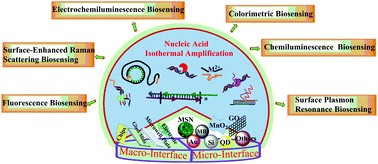Optical nano-biosensing interface via nucleic acid amplification strategy: construction and application
Abstract
Modern optical detection technology plays a critical role in current clinical detection due to its high sensitivity and accuracy. However, higher requirements such as extremely high detection sensitivity have been put forward due to the clinical needs for the early finding and diagnosing of malignant tumors which are significant for tumor therapy. The technology of isothermal amplification with nucleic acids opens up avenues for meeting this requirement. Recent reports have shown that a nucleic acid amplification-assisted modern optical sensing interface has achieved satisfactory sensitivity and accuracy, high speed and specificity. Compared with isothermal amplification technology designed to work completely in a solution system, solid biosensing interfaces demonstrated better performances in stability and sensitivity due to their ease of separation from the reaction mixture and the better signal transduction on these optical nano-biosensing interfaces. Also the flexibility and designability during the construction of these nano-biosensing interfaces provided a promising research topic for the ultrasensitive detection of cancer diseases. In this review, we describe the construction of the burgeoning number of optical nano-biosensing interfaces assisted by a nucleic acid amplification strategy, and provide insightful views on: (1) approaches to the smart fabrication of an optical nano-biosensing interface, (2) biosensing mechanisms via the nucleic acid amplification method, (3) the newest strategies and future perspectives.

- This article is part of the themed collection: Probes for in vitro and in vivo fluorescence imaging


 Please wait while we load your content...
Please wait while we load your content...